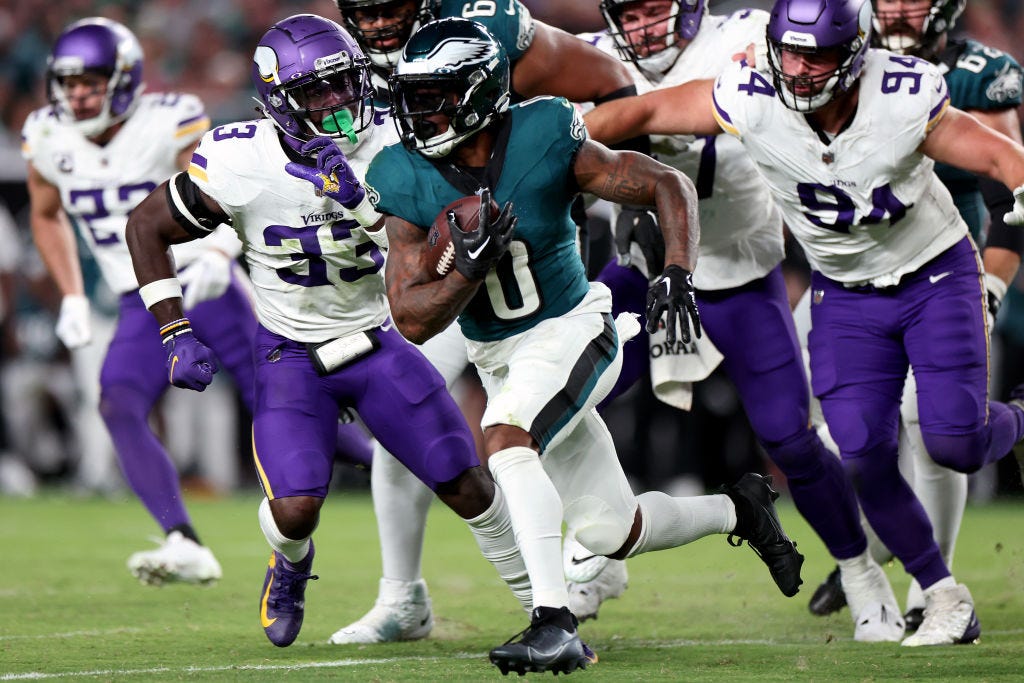Vikings Run Defense By the Numbers: How Bad Is It Actually?
Matt Fries investigates how poor the Vikings run defense is, whether it's worth any tradeoffs and what the film says about their approach to defending the run
The Vikings made a concerted effort to improve their interior on both sides of the ball this past offseason, with massive investments on the offensive and defensive lines. On defense, that meant bringing in Javon Hargrave and Jonathan Allen at a combined annual salary of $32 million.
At the time, it felt like the team had solidified an interior trio that could provide a bit of everything. Allen and Hargrave were very much needed to upgrade an interior pass rush that was absolutely toothless, and Harrison Phillips had provided excellent run defense from 2022 to 2024.
When training camp rolled around, the team realized it had a different, though not entirely bad, problem on its hands. Allen, Hargrave, and Phillips looked to lead the room, but the team’s depth at the position had also shown out.
Jalen Redmond, an incredible find from the UFL, was consistently making splash plays. Levi Drake Rodriguez, in his second year, was also clearly making an impact. Tyrion Ingram-Dawkins was a promising 5th-round draft pick. Beyond them, Taki Taimani and undrafted rookie Elijah Williams felt like roster-caliber players.
All of that talent led the Vikings to make a move to relieve roster pressure. That move was trading Phillips to the Jets. This cleared the path for Hargrave to be the team’s primary nose tackle, with Rodriguez serving as the backup.
The book on Hargrave as he joined the Vikings was that he is a strong pass rusher who struggles to hold up against the run, so this naturally led me to question the move, and I advocated for keeping Taimani (currently on the practice squad) on the roster:
With Phillips gone, the Vikings lost their best run-defending interior defender. Hargrave reportedly played a significant amount of NT in camp, but he has been extremely poor against the run at his recent stops. I would not expect that to improve significantly, so the Vikings need to keep a player who is a strong interior run defender. For me, that is Taki Taimani. Taimani offers little as a pass rusher, but he was stout against the run in limited reps during the regular season last year before getting injured. He is the only player the Vikings currently have that I trust to play nose tackle against double teams.
Fast forward to the present, where the Vikings just allowed 99 yards rushing to Kenneth Gainwell, easily the highest mark in the 5th-year RB’s career. As it stands, the Vikings are allowing 130.2 rush yards/game, 9th most in the NFL. Last year, 93.4 rush yards/game, 2nd fewest in the NFL.
Box score stats certainly don’t give the whole story, but they do indicate a direction. Let’s dive into a more advanced look at the Vikings’ run defense, using both the stats and the film.
Where Does the Vikings Run Defense Stand?
The four games the Vikings have played all had very different feels to them. Against the Bears, neither offense really had much success until the Vikings took over the game in the 4th quarter. The Falcons mounted a number of successful drives on the ground, but were ineffective throwing the ball, and it kept the Vikings in the game for way longer than they should have been.
The Bengals game featured a complete takeover by the Vikings defense, who shut down the Bengals’ offense. And this past Steelers game felt like the first time the team had struggled in both phases, but particularly so against the run.
In summary, that’s two games that felt like excellent run defense and two games of bad run defense (as a note, I’m talking specifically about designed runs, and all of the data below categorizes QB scrambles as pass plays). The advanced metrics bear this out, as you can see from these box scores provided by rbsdm.com:
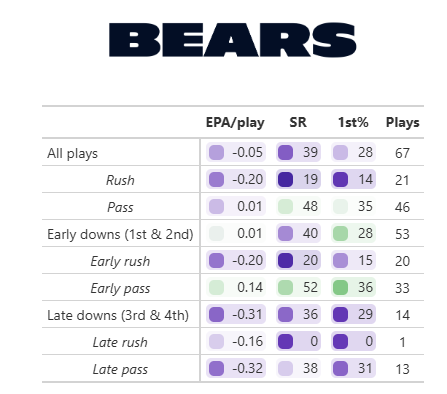
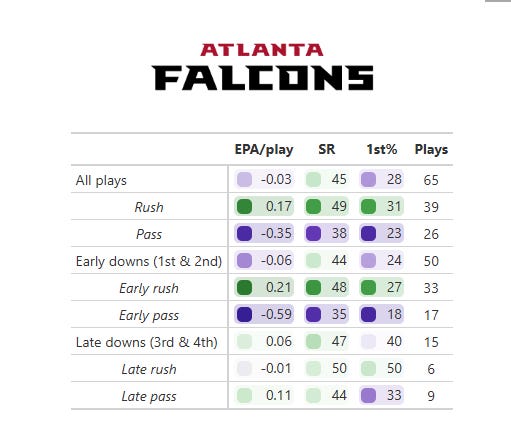
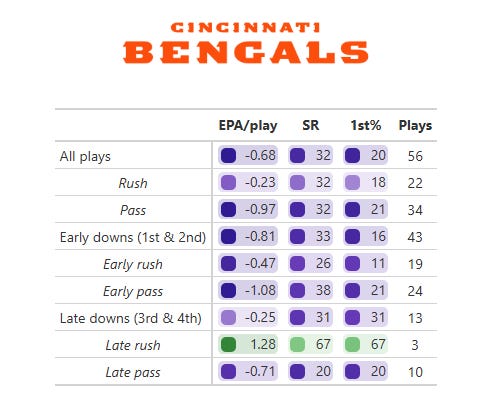
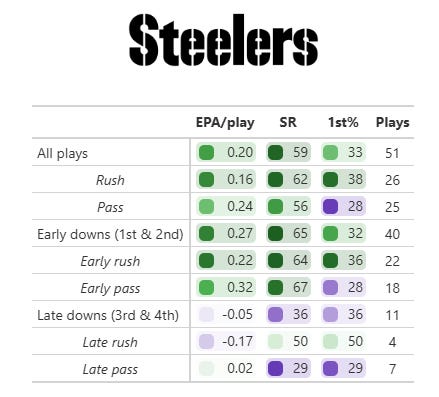
How bad was the run defense’s performance against the Steelers? Well, let’s try to put it in perspective. Every so often, the Vikings have a game that seems to start an existential crisis among the fanbase about the defense. You know, the ones where the podcasts the week after are all titled “Has Brian Flores’ defense been SOLVED?!?”
[Ed. Note: Arif Hasan does not pick any of the titles for the podcasts he’s on]
Last year, those circumstances came in the form of a pair of back-to-back matchups against the Lions and Rams. In particular, the run defense came into question after the Lions’ Jahmyr Gibbs had a combined 255 yards and 5 TDs on the ground in Weeks 7 and 17 last year. Well, here are the advanced box scores for those two games:
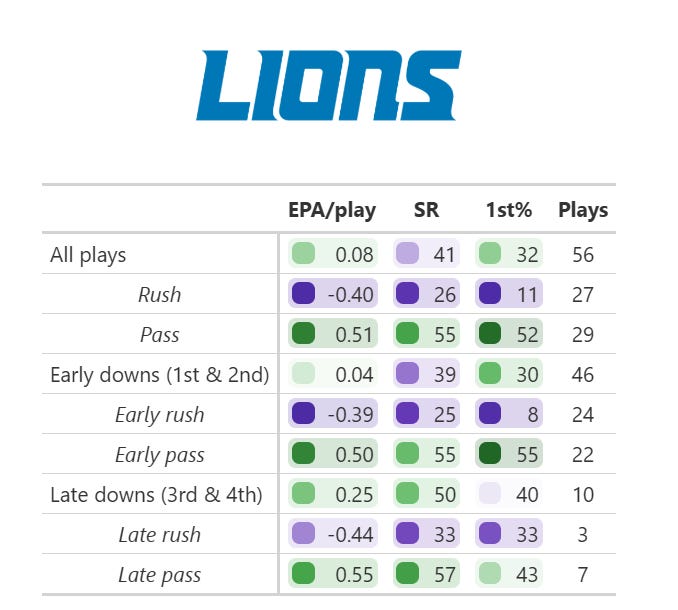
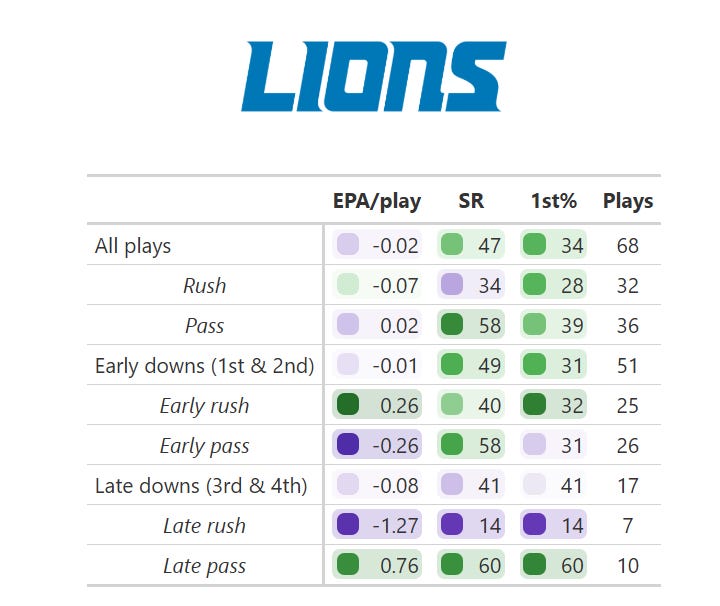
The EPA/play for Week 7’s game was significantly impacted by fumbles, but the success rate still helps tell the story. Even if Gibbs broke off explosive plays, the Vikings actually held their own against the Lions’ dominant attack on a play-by-play basis, keeping them to a success rate of 26 percent, a 15th percentile outcome. By the numbers, the Steelers game was significantly worse than both of their performances last year against Detroit.
In fact, there’s really only one game in Flores’ tenure that looks worse from a run defense perspective, and the overall numbers are very similar: Week 2 of 2023 against the Philadelphia Eagles.
The defining feature of that game was the Eagles’ exploitation of Flores’ new, funky, blitz-focused defense by running the ball right at it. The Vikings played with extremely light boxes in the game, often having Phillips as the lone defensive tackle, with at least five defensive backs on the field.
That, combined with the Eagles dominant offensive line, can pretty easily explain that box score, although it should be noted that the Eagles were without Gainwell, who missed the game due to injury (fun fact: Sunday’s game was by far Gainwell’s career high in attempts, with 19; tied for second place are his 14 attempts in Weeks 1 and 3 of 2023, which bookend the game above).
The Lions and Eagles games stick out in memory, but it’s also noteworthy that their respective run games were both reputationally and statistically excellent. Both teams are renowned for their offensive lines, and the Eagles have the advantage of a rushing threat at quarterback in Jalen Hurts. Both teams had top-five run games over the course of the 2023 and 2024 seasons.
If you look at the group the Vikings have faced, they’re not exactly world beaters. Here are the ranks in EPA/play and success rate on the ground for each team so far:
The Vikings’ run defense had dominant performances against two teams that are bad at running the football, the Bears and Bengals. The Bengals, in particular, had some of the worst execution I’ve ever seen in a run game, and the Bears’ rush EPA/play against the Vikings was somehow actually higher than their season average so far.
Then the Vikings had what were essentially league-worst performances against the Falcons and Steelers. The Giants allow an NFL-worst 0.167 EPA/play on the ground. They’re also the worst in terms of success rate, at 50.0%. The numbers in the box scores above are very comparable to what the Giants are currently allowing.
The Falcons, despite an incredible running back in Bijan Robinson, have been a mediocre run team so far. The Steelers, who don’t have any names that impress you, have pretty good numbers. The Steelers’ success rate is propped up by the Vikings game (it would be 41.7%, ranked 14th, if you removed the week 4 game from the dataset), but they look like an above-average unit.
Overall, the Vikings run defense does not look good. The Vikings are allowing 0.016 rush EPA/play, 26th in the NFL and a 42.6% success rate, 20th in the NFL. Those numbers would have ranked 30th and 24th, respectively, in 2024. Their 2024 defense allowed just -0.203 rush EPA/play, the best in the NFL, and a 35.8% success rate, the third-best in the NFL.
So far, I’ve been using EPA/play and success rate, but this also bears out using other numbers as well. NFL Pro provides NextGenStats numbers for Rush Yards Over Expected and Yards Before Contact/Attempt. The Vikings currently allow plus-0.51 RYOE/att, ranked 21st and 1.33 YBCo/att, ranked 20th. In 2024, they allowed minus-0.10 RYOE/att and plus-1.06 YBCo/att, both top-five numbers.
What’s Causing the Run Defense Issue?
Over the course of the season, I’ve noticed that the Vikings have been using heavier personnel. This particularly showed up on third downs, where they would often keep Hargrave, Allen, and Redmond on the field. This was a striking difference from last year, where the defense often used four players listed as edge rushers on 3rd down – mostly Jihad Ward, Jonathan Greenard, Andrew Van Ginkel, and one of Dallas Turner or Pat Jones.
I wanted to see if this was supported by the data. NFLGSIS demonstrates that it pretty clearly is. The Vikings are using 4 DBs and at least 3 IDL (what I consider their “base” defense) on 56.8% of plays. They played just 174 snaps of this configuration (even making sure to count Ward as an IDL player, not an EDGE) last year, and have already played 130 snaps this year.
Keep reading with a 7-day free trial
Subscribe to Wide Left to keep reading this post and get 7 days of free access to the full post archives.





